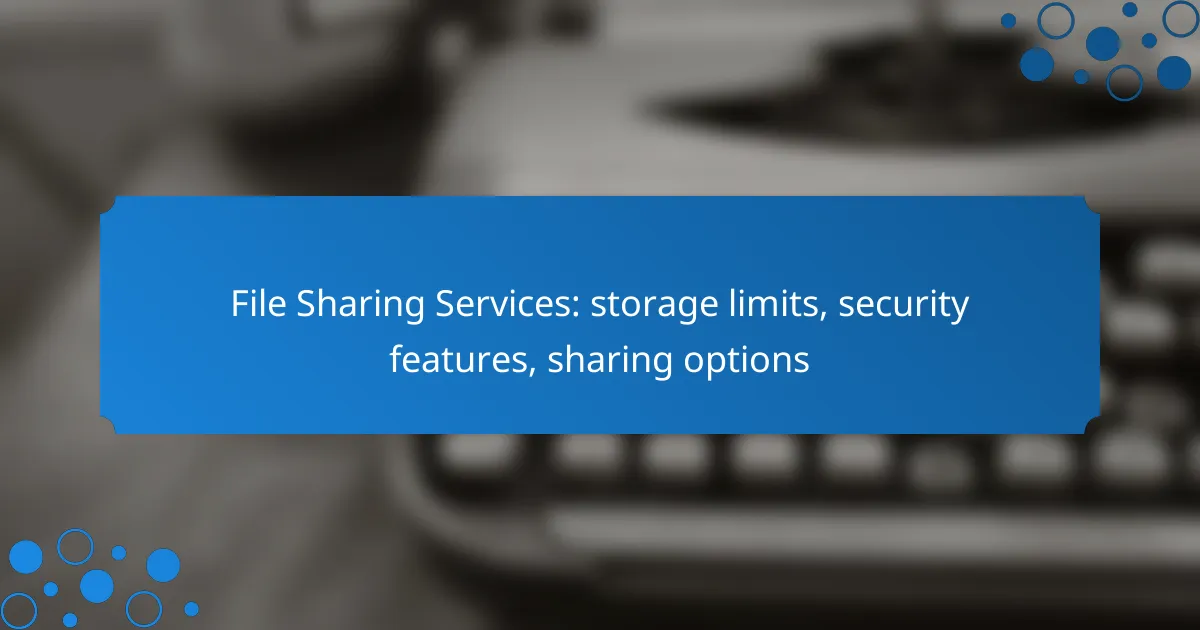File sharing services provide essential tools for users to store, share, and collaborate on documents seamlessly. With varying storage limits, security features, and sharing options, it’s important to evaluate each service’s offerings to find the best fit for your needs. Popular platforms like Dropbox, Google Drive, and OneDrive stand out for their user-friendly interfaces and robust security measures.

What are the best file sharing services in Australia?
The best file sharing services in Australia combine user-friendly interfaces, robust security features, and flexible sharing options. Popular choices include Dropbox, Google Drive, OneDrive, Box, and WeTransfer, each offering distinct advantages depending on user needs.
Dropbox
Dropbox is a widely used file sharing service known for its simplicity and reliability. It offers a free plan with limited storage, typically around 2 GB, and paid plans that can go up to several terabytes.
Security features include file encryption during transfer and at rest, along with two-factor authentication. Users can easily share files via links, and collaboration tools allow for real-time editing and commenting.
Google Drive
Google Drive provides 15 GB of free storage, which is shared across Google services. This platform is ideal for users who already utilize Google Workspace, as it integrates seamlessly with applications like Docs, Sheets, and Gmail.
Security measures include encryption and advanced sharing settings that allow users to control access levels. Google Drive’s sharing options are versatile, enabling users to share files with specific people or generate public links.
OneDrive
OneDrive, part of Microsoft 365, offers 5 GB of free storage, with additional space available through subscription plans. It is particularly beneficial for users in the Microsoft ecosystem, as it integrates with Office applications.
OneDrive emphasizes security with features like personal vaults for sensitive files and file recovery options. Sharing is straightforward, allowing users to set permissions and share links easily.
Box
Box is designed for businesses and offers a free plan with 10 GB of storage. Paid plans provide extensive collaboration tools and integrations with various applications, making it suitable for team environments.
Security features include advanced encryption, compliance with regulations like GDPR, and customizable access permissions. Box also allows users to share files securely with external partners through shared links.
WeTransfer
WeTransfer is a simple file sharing service that allows users to send files up to 2 GB for free without needing an account. It’s ideal for quick transfers, especially for large files like videos or presentations.
While WeTransfer does not focus heavily on storage or collaboration, it offers basic security through encrypted transfers. Users can share files via email or a link, making it a convenient option for one-time sharing needs.

What are the storage limits of popular file sharing services?
Popular file sharing services typically offer a range of storage limits, which can vary based on the subscription plan. Users should consider their storage needs and the features provided by each service to choose the best option.
Dropbox storage limits
Dropbox offers various plans with different storage capacities. The free Basic plan provides 2 GB of storage, while the Plus plan offers 2 TB. For teams, the Professional plan includes 3 TB, and the Business plans can provide even more, depending on the specific needs of the organization.
When selecting a plan, consider how much data you regularly store and share. Upgrading to a higher tier can be beneficial for users with extensive storage needs.
Google Drive storage limits
Google Drive starts with 15 GB of free storage, shared across Google services like Gmail and Google Photos. Paid plans under Google One offer additional storage options, ranging from 100 GB to 2 TB, and even higher for enterprise users.
It’s essential to monitor your usage, as exceeding the limit can restrict your ability to upload new files. Regularly cleaning up unnecessary files can help manage your storage effectively.
OneDrive storage limits
OneDrive provides 5 GB of free storage, with paid plans offering more space. The Microsoft 365 subscription includes 1 TB of storage, while business plans can provide up to 6 TB per user, depending on the plan type.
Users should evaluate their storage needs against the available plans to ensure they have sufficient space for their files, especially if they are using OneDrive for business purposes.
Box storage limits
Box offers 10 GB of free storage for individual users, but paid plans significantly increase this limit. The Business plan starts at 100 GB, with options for unlimited storage available for larger organizations.
When choosing Box, consider the collaborative features it offers alongside storage, as these can enhance productivity for teams working on shared projects.

How secure are file sharing services?
File sharing services can be secure, but their level of protection varies significantly based on the features they offer. Key factors include encryption methods, two-factor authentication, and compliance with industry standards, all of which play a crucial role in safeguarding your data.
Encryption methods
Encryption is a fundamental security feature for file sharing services, ensuring that your files are protected during transfer and while stored. Most reputable services use end-to-end encryption, meaning only you and the intended recipient can access the files. Look for services that employ strong encryption protocols like AES-256, which is widely recognized as secure.
Some services may offer encryption at rest and in transit, providing an additional layer of security. Be cautious of services that do not clearly state their encryption practices, as this can expose your data to potential breaches.
Two-factor authentication
Two-factor authentication (2FA) adds an extra layer of security by requiring a second form of verification beyond just a password. This could be a code sent to your mobile device or an authentication app. Enabling 2FA significantly reduces the risk of unauthorized access to your files.
When choosing a file sharing service, check if it supports 2FA and consider using it as a standard practice. Avoid services that do not offer this feature, as they may leave your data vulnerable to attacks.
Compliance standards
Compliance with industry standards is crucial for ensuring that file sharing services meet specific security requirements. Look for services that comply with regulations such as GDPR in Europe or HIPAA in the United States, especially if you are handling sensitive information.
Services that adhere to these standards typically undergo regular audits and maintain high security protocols. Always verify the compliance certifications of a file sharing service to ensure your data is handled responsibly and securely.

What sharing options do file sharing services offer?
File sharing services provide various options for sharing files and folders, enabling users to collaborate efficiently. Common methods include link sharing, folder sharing, and setting access permissions to control how others interact with shared content.
Link sharing
Link sharing allows users to generate a unique URL that can be sent to others for accessing specific files or folders. This method is convenient for quick sharing, as recipients do not need to create an account to view or download the content.
When using link sharing, consider whether to enable options like password protection or expiration dates for the links. This adds an extra layer of security and ensures that access is limited to a specific timeframe.
Folder sharing
Folder sharing enables users to share entire folders with others, allowing for easier collaboration on multiple files at once. This is particularly useful for teams working on projects where several documents need to be accessed simultaneously.
When sharing folders, users can often choose whether to grant view-only access or editing capabilities. It’s essential to communicate clearly with collaborators about their permissions to avoid accidental changes or deletions.
Access permissions
Access permissions determine what recipients can do with shared files or folders. Common permission levels include view-only, comment, and edit, which can be assigned based on the needs of the collaboration.
To manage access effectively, regularly review who has permissions and adjust them as necessary. This helps maintain control over sensitive information and ensures that only authorized users can make changes.

What criteria should you consider when choosing a file sharing service?
When selecting a file sharing service, consider storage capacity, security features, and integration capabilities. These factors will help ensure that the service meets your needs for file management, protection, and compatibility with other tools.
Storage capacity
Storage capacity refers to the amount of data you can store on the file sharing service. Most services offer a range of options, from free tiers with limited space (often around 2-5 GB) to paid plans that can provide hundreds of gigabytes or even terabytes of storage.
Evaluate your storage needs based on the types of files you share and how frequently you need to access them. For instance, if you regularly share high-resolution images or large video files, opt for a service that offers ample storage and consider plans that allow for easy upgrades.
Security features
Security features are crucial for protecting sensitive information during file sharing. Look for services that provide encryption, both in transit and at rest, to safeguard your files from unauthorized access.
Additionally, consider services that offer two-factor authentication (2FA) and customizable sharing permissions. These features can help you control who accesses your files and reduce the risk of data breaches.
Integration capabilities
Integration capabilities determine how well the file sharing service works with other applications you use. A good service should seamlessly integrate with productivity tools like Google Workspace, Microsoft Office, or project management software.
Check if the service offers APIs or plugins that allow for easy connection with your existing workflows. This can enhance efficiency and streamline collaboration, making it easier to share files without disrupting your usual processes.
